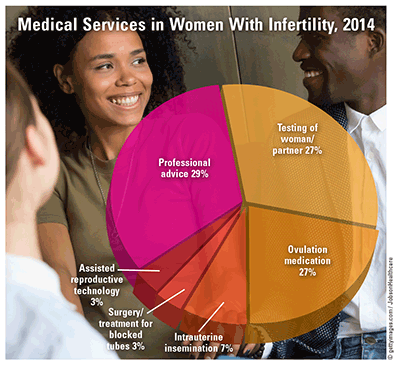US Pharm. 2018;43(9):14.
National Survey of Family Growth (NSFG) data indicate that 15.5% of all women who intend to become pregnant are infertile (unable to conceive after 1 year of trying) and 6.7% of married women aged 15 to 44 years are infertile. Fecundity is impaired (i.e., physical difficulty in conceiving or carrying a pregnancy to live birth) in 12% of women, regardless of marital status, and in 23.6% of married childless women.

Prevalence: The NSFG reported that from 2011 to 2015, among women aged 15 to 44 years, the percent distribution of those who were childless was 45.1%, and that of women who were involuntarily childless (physically unable to have children) was 2.1%. According to the National Women’s Health Resource Center, couples aged 29 to 33 years with normal-functioning reproductive systems had a 20% to 25% chance of conceiving in any given month, and after 6 months of trying, 60% of couples conceived without medical assistance.
Treatment: For the period from 2011 to 2015, the NSFG reported that 11.9% of women (7.3 million) aged 15 to 44 years received infertility services from healthcare professionals. The types of services provided were advice (6.3%), medical help to prevent miscarriage (5.4%), testing (5.2%), ovulation drugs (4.2%), and artificial insemination (1.4%). Among infertile women, 44% sought medical intervention and 65% gave birth. Approximately 85% to 90% of female infertility cases were treated with drug therapy or surgical procedures. Fewer than 3% needed advanced reproductive technologies such as in vitro fertilization (IVF). According to the CDC’s report on assisted reproductive technology (ART) success rates, live birth rates per fresh nondonor embryo transfers were 38%, 32%, 23%, 14%, 7%, and 3%, respectively, in women aged <35, 35 to 37, 38 to 40, 41 to 42, 43 to 44, and >44 years. Of the 263,577 ART cycles performed in 2016, 25% resulted in 65,996 live births (i.e., deliveries of 1 or more infants), 29.2% resulted in 76,930 live-born infants, and 25% (65,840) were performed with the intention of freezing the embryos for the future. Demand for ART has doubled over the last decade, and currently 1.7% of all infants born every year are conceived via ART.
Emotional Impact of Infertility: Fewer than 50% of women who could benefit from medical/behavioral services received such services. In couples diagnosed with female factor infertility, wives experience significantly more depression than their husbands. Compared with women who conceive naturally, those who conceive after IVF have greater pregnancy-specific anxiety, poorer quality of life, less depression, similar self-esteem, more positive attitudes toward pregnancy demands, and higher levels of maternal-fetal attachment.
To comment on this article, contact rdavidson@uspharmacist.com.






